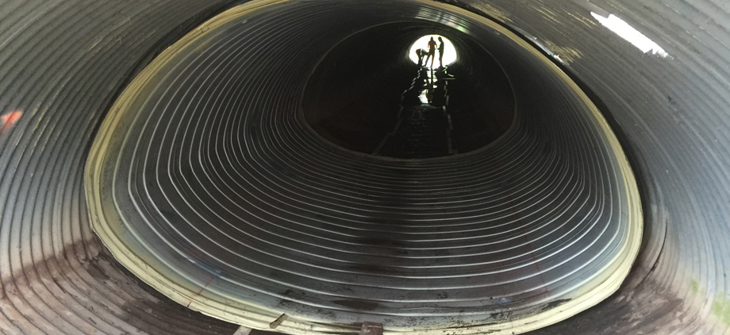
Reline or Replace? How to Assess the Condition of an Existing Culvert.
When a culvert or storm sewer reaches the end of its useful service life, the option to excavate and replace is commonplace. However, having the additional option to reline the existing structure to provide a structural solution can save significant time and money.
A key to determining whether or not to excavate and replace or to structural reline an existing pipe is to assess the condition of the current pipe.
Inspecting the current conditions of the existing pipe is a crucial step to determining whether or not a reline solution is an option. Full corrosion or structural failure can make it an unsafe workspace and inspection and review by a qualified professional must be taken into consideration when a reline may require entry into the existing pipe, and when its failure would compromise public safety. What constitutes full corrosion or structural failure is a debatable topic, but care must be taken when working underground.
A compromised structure can be mitigated by doing one or more of the following:
- Remove live load traffic directly over the work area.
- Inject grout into any voids created by the moving structure and its soil envelope.
- Brace/strut the interior to prevent further movement.
With pipes that have corroded inverts only, a horseshoe shaped arch (with a properly designed cross-strut at its base) that remains from one side of the invert corrosion, around the top to the other side, can be enhanced to provide the safe working environment needed.
If the corrosion line extends up the side walls, this can be more challenging. Short segments of welded on steel flat stock or pipes can allow the loads to be bridged across a corrosion line. These can be welded into the corrugations as needed.
Any of these techniques need to be detailed and reviewed by qualified individuals, but it’s not rocket science.
Another important consideration in this assessment is the hydraulics. Hydraulic performance expectations must be considered in conjunction with decisions around what can physically be built. It’s surprising how many inlet control culverts get lined with a smooth product or process in the spirit of simplistic Manning’s equation capacity comparisons when Manning’s ‘n’ values before and after have no impact on the actual capacity of most culverts. Inlet control and outlet control flow regimes must be checked and the one producing the highest headwater depth governs how it is operating.
In summary, there really is no clear-cut answer to this question. Ultimately, an inspection of the existing pipe and a clearly outlined reline plan must be considered, along with a review of hydraulic performance before and after the relining work is done. Construction-wise, the ultimate deciding factor should be the safety of those involved in the reline work. If hydraulic goals can’t be reached with a safe construction plan, replacement is probably the best option.
